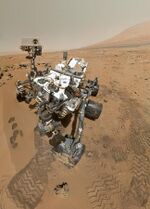Astronomy:HD 40307 f
| Discovery | |
|---|---|
| Discovered by | Mikko Tuomi et al. |
| Discovery site | La Silla Observatory, Chile |
| Discovery date | October 28, 2012 |
| radial velocity, using HARPS | |
| Orbital characteristics | |
| 0.247 [0.233, 0.258] AU | |
| Eccentricity | 0.03 [0, 0.13][1] |
| Orbital period | 51.76 [51.30, 52.26][1] d |
| Semi-amplitude | 1.09 [0.77, 1.37][1] |
| Star | HD 40307 |
HD 40307 f is an extrasolar planet orbiting the star HD 40307. It is located 42 light-years away in the direction of the southern constellation Pictor. The planet was discovered by the radial velocity method, using the European Southern Observatory's HARPS apparatus[1][2][3] by a team of astronomers led by Mikko Tuomi at the University of Hertfordshire and Guillem Anglada-Escude of the University of Göttingen, Germany .[4] The existence of planet was confirmed in 2015.[5]
Planetary characteristics
This planet is the fifth planet from the star, at a distance of about 0.25 AU (compared to 0.39 AU for Mercury) with negligible eccentricity.
HD 40307 f's minimum mass is 5.2 that of Earth, and dynamical models suggest it cannot be much more (and so is measured close to edge-on).[1] Planets like this in that system have been presumed "super-Earth".[6]
Even though HD 40307 f is closer to the star than Mercury is to the Sun,[7] it gets (slightly) less insolation than Mercury gets because the parent star is dimmer than our home star.[8] It still gets more heat than Venus gets (like Gliese 581 c), and it has more gravitational potential than Venus has. HD 40307 f is more likely a super-Venus than a "super-Earth".[9]
Moreover, planets b, c, and d are presumed to have migrated in from outer orbits; and planet b is predicted a sub-Neptune.[10]
References
- ↑ 1.0 1.1 1.2 1.3 1.4 Tuomi, Mikko; Anglada-Escudé, Guillem; Gerlach, Enrico; Jones, Hugh R. A.; Reiners, Ansgar; Rivera, Eugenio J.; Vogt, Steven S.; Butler, R. Paul (17 December 2012). "Habitable-zone super-Earth candidate in a six-planet system around the K2.5V star HD 40307". Astronomy & Astrophysics 549: A48. doi:10.1051/0004-6361/201220268. Bibcode: 2013A&A...549A..48T.
- ↑ Wall, Mike (November 7, 2012). "'Super-Earth' Alien Planet May Be Habitable for Life". Space.com. http://www.space.com/18393-alien-planet-super-earth-habitable-hd-40307g.html.
- ↑ Tate, Karl (November 7, 2012). "Super-Earth Planet: Potentially Habitable Alien World Explained (Infographic)". Space.com. http://www.space.com/18390-super-earth-exoplanet-habitable-zone-infographic.html.
- ↑ Murrin, Marc (November 8, 2012). "Astronomers discover a potentially habitable Super-Earth HD 40307g (Infographic)". tech-stew.com. http://www.tech-stew.com/post/2012/11/08/Astronomers-discover-a-potentially-habitable-Super-Earth-HD40307g.aspx.
- ↑ Díaz, R. F. et al. (2016). "The HARPS search for southern extra-solar planets. XXXVIII. Bayesian re-analysis of three systems. New super-Earths, unconfirmed signals, and magnetic cycles". Astronomy and Astrophysics 585: A134. doi:10.1051/0004-6361/201526729. Bibcode: 2016A&A...585A.134D. https://www.aanda.org/articles/aa/full_html/2016/01/aa26729-15/aa26729-15.html.
- ↑ M. Mayor; S. Udry; C. Lovis; F. Pepe; D. Queloz; W. Benz; J.-L. Bertaux; F. Bouchy et al. (2009). "The HARPS search for southern extra-solar planets. XIII. A planetary system with 3 Super-Earths (4.2, 6.9, & 9.2 Earth masses)". Astronomy and Astrophysics 493 (2): 639–644. doi:10.1051/0004-6361:200810451. Bibcode: 2009A&A...493..639M.
- ↑ "Mercury Fact Sheet". NASA Goddard Space Flight Center. November 17, 2010. http://nssdc.gsfc.nasa.gov/planetary/factsheet/mercuryfact.html.
- ↑ Tuomi, Fig 17
- ↑ Tuomi, Fig 17 cites Fig 4 in Selsis, Franck; Kasting, James F.; Levrard, Benjamin; Paillet, Jimmy; Ribas, Ignasi; Delfosse, Xavier (2007). "Habitable planets around the star Gl 581?". Astronomy and Astrophysics 476 (3): 1373–1387. doi:10.1051/0004-6361:20078091. Bibcode: 2007A&A...476.1373S. https://hal.archives-ouvertes.fr/hal-00182743., "100% clouds" region
- ↑ Barnes, R.; Jackson, B.; Raymond, S.; West, A.; Greenberg, R. (2009). "The HD 40307 Planetary System: Super-Earths or Mini-Neptunes?". The Astrophysical Journal 695 (2): 1006–1011. doi:10.1088/0004-637X/695/2/1006. Bibcode: 2009ApJ...695.1006B.
External links
- "Super-Earth Discovered in Star's Habitable Zone". Exoplanets. 2017-05-10. http://news.discovery.com/space/habitable-zone-exoplanet-super-earth-121107.html.
Coordinates: ![]() 05h 54m 04.2409s, −60° 01′ 24.498″
05h 54m 04.2409s, −60° 01′ 24.498″
 |



